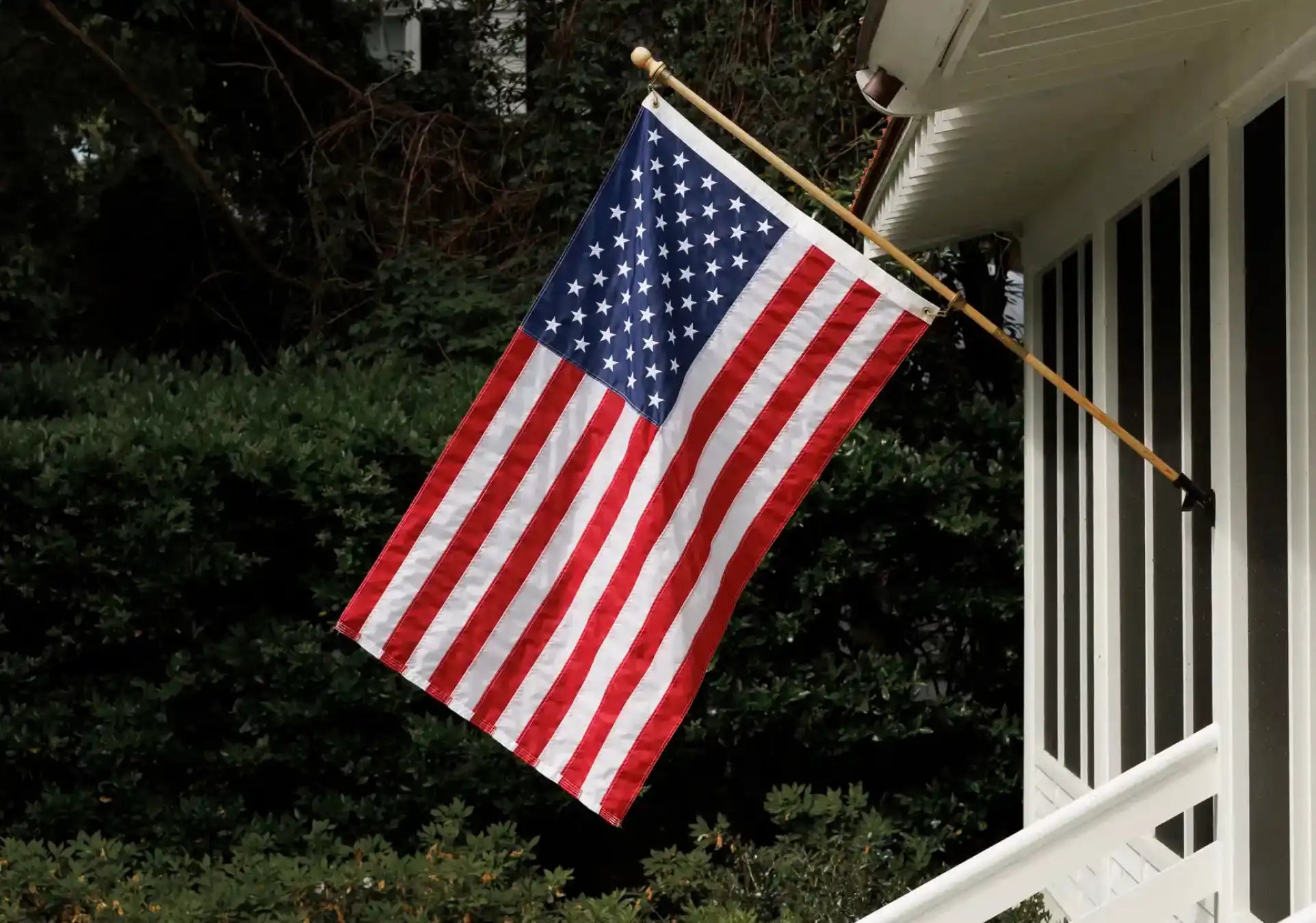Respect for the American flag is a fundamental aspect of national pride and patriotism. Understanding and adhering to American flag etiquette is crucial for anyone who wishes to display the flag. This set of guidelines not only ensures that the flag is treated with the dignity it deserves but also unites us in a common practice of reverence. Whether flown outside a home, inside a school, or at public buildings, the way we handle and display the American flag speaks volumes about our respect for the country it represents.
Basic Dos and Don'ts of American Flag Display
Correct Positioning and Display Order
The proper American flag display dictates that when the flag is hung with other flags, such as state or local flags, the American flag should always be in the position of honor — to the observer's left when displayed against a wall with other flags. If displayed from crossed staffs, the American flag should be on the right (the flag’s right) and its staff should be in front of the other flags’ staffs.
Proper Times and Conditions for Display
The American flag can be displayed every day, but it is especially important to fly it on national holidays and other significant dates. According to American flag display rules, the flag should be displayed from sunrise to sunset on buildings and stationary flagstaffs in the open. However, it may be displayed 24 hours a day if properly illuminated during the hours of darkness, symbolizing the nation's idea that 'freedom never sleeps'.
Handling Flags in Poor Weather Conditions
Traditional etiquette advises against displaying the American flag in inclement weather unless it is an all-weather flag made of durable materials designed to withstand the elements. The principle behind this guideline is to protect the flag from damage and to show respect for the emblem. However, outdoor American flag protocol has adapted to modern materials, allowing the flag to be flown in various weather conditions.
Respectful Disposal of Worn or Damaged Flags
When an American flag becomes worn, faded, or otherwise damaged, it should not be thrown away carelessly. The respectful disposal of such flags is an important part of flag etiquette. There are specific ceremonies for American flag folding protocol and disposal, often performed by organizations like the Boy Scouts, Girl Scouts, or the American Legion. These ceremonies typically involve properly folding the flag and then burning it to ashes in a dignified manner.
Protocols for Raising and Lowering the Flag
The Correct Procedure for Raising the Flag
The raising of the flag is a ceremonial act that carries deep significance, symbolizing respect, patriotism, and unity. The procedure is steeped in tradition and follows a specific sequence to honor the flag and what it represents. Below is a guide:
-
Attach the Flag: The first step involves attaching the flag to the halyard with care, ensuring that it is secured properly and that it does not touch the ground. By taking this action, we are demonstrating our appreciation for the flag and the ideals it represents, such as justice, freedom, and the sacrifices made by those who have upheld these beliefs.
-
Salute: As the flag is being hoisted, those present should face the flag with solemn respect, placing their right hand over their heart. This gesture is a sign of honor and loyalty to the country, reflecting a moment of personal commitment to the ideals symbolized by the flag.
-
Raise Briskly: The flag should be hoisted quickly to the top of the flagpole. This brisk action reflects the strength and resilience of the nation and its people. It symbolizes the rise of the country through challenges and the continuous pursuit of excellence and unity.
-
Observe a Moment of Silence: Once the flag reaches the top, it is customary to observe a moment of silence. This pause allows individuals to reflect on the flag's profound significance, the values it upholds, and the collective history of the nation. It's a moment to contemplate the responsibilities of citizenship and the role each individual plays in maintaining and advancing those ideals.
The procedure for raising the flag is not merely a routine but a ritual that fosters a sense of community and shared purpose. It serves as a reminder of the nation's ideals, the sacrifices made to protect those values, and the ongoing commitment required to uphold them. Through this ritual, individuals are connected to the larger narrative of the nation, fostering a sense of belonging and shared responsibility.
Lowering the Flag: Timing and Methodology
Lowering the American flag is conducted with equal solemnity as raising it. The flag is lowered slowly and ceremoniously, a reflective action symbolizing the end of the day and a moment to honor those who have served the country. As the flag is carefully brought down, all observers should face the flag, rendering the same respect as when it was raised. Once fully lowered, it should be removed from the halyard and folded properly.
Flag Half-Staff Rules
The President or state governors can order the flag to be flown at half-staff. This is a sign of mourning during times of national tragedy or to honor the death of a significant national figure. This position of the flag serves as a collective expression of grief and respect from the nation.
Patriotic Decor and Public Displays
Guidelines for Using the Flag in Decorations
The use of the American flag in decorations is governed by a set of guidelines that ensure its treatment with the utmost respect. Patriotic flag decor should enhance the flag's dignity, not diminish it. When incorporating the flag into decorations, it is crucial to follow these principles to demonstrate patriotism for the country:
-
Position of Prominence: The American flag should always be placed in a position of prominence over all other decorative elements. This means it should be the most visible and distinguished item in any decorative arrangement, symbolizing its importance and the respect it commands.
-
Unaltered State: When displayed, the flag should always be in its original form, without any modifications or alterations for decorative purposes. The flag's integrity, colors, and design should be preserved, appreciating its official appearance and the significance each element holds.
-
Superior Placement: In settings where multiple flags are displayed, the American flag should always be placed to the observer's left or in a superior position to any other flags, including state, local, or organizational flags. When flags are crossed, the American flag should be to the observer's left and its staff should be in front of the other flag's staff, symbolizing its precedence.
Adhering to these guidelines ensures that the American flag is displayed with the honor it deserves in any decorative context. These practices reflect a deep reverence for the nation's values and history, promoting a sense of patriotism and pride. By following these principles, individuals and organizations can demonstrate their commitment to honoring the flag and the ideals it represents.
Dos and Don'ts of Wearing Flag-themed Apparel
While expressing patriotism through flag-themed apparel is popular, it's important to do so with respect for the flag's image. The U.S. Flag Code advises against using the flag as apparel, bedding, or drapery. Clothing that features the flag should not replicate the flag exactly but rather suggest the flag's design tastefully.
Incorporation of the Flag in Art and Advertising
The American flag's image in art and advertising must be handled with care to avoid misinterpretation. While artistic expression is valued, any representation of the flag should maintain the dignity it commands. This means avoiding implications that the flag is endorsing a product or service and ensuring the flag's depiction is consistent with the principles of honor.
American Flag Folding and Storage
The Symbolic Meaning Behind Each Fold
The tradition of folding the American flag is rich with symbolism, each fold is a testament to the principles and values the flag represents. This ceremonial act is more than just a practical way to store the flag; it's a ritual that honors the history, bravery, and sacrifice symbolized by the flag. The precise 13 folds embody the original 13 colonies, and each fold has its significance, from liberty and justice to the tribute to the armed forces.
Properly Folding the Flag
The process involves two people, who start by holding the flag horizontally at waist level. The flag is then folded lengthwise, and then a series of triangular folds is made, starting from the striped end until only the blue field with stars is visible. This method of folding is a way to ensure that the American flag folding protocol is maintained, symbolizing the nation's principles and ensuring the flag is stored with the respect it deserves.
Storing the Flag: Best Practices
Once folded according to protocol, the flag should be kept in a dry, safe place, away from any areas that might expose it to wear or damage. It's essential to protect the flag from fading, moisture, and other elements that could degrade its quality. By following these best practices, individuals and organizations can ensure that their flags are preserved.
Purchasing and Maintaining American Flags
Choosing Flags that Meet Official Specifications
When looking to buy American flag, it's vital to select one that adheres to official specifications. Official flags are made from durable materials, feature precise colors, and follow exact dimensions. By choosing a flag that meets these criteria, individuals and organizations demonstrate a commitment to honoring the nation's symbol properly.
Recommendations for Online Flag Stores
For those looking to buy American flag online, it's important to choose reputable online flag stores. These stores offer a wide variety of flags that comply with official standards. When selecting a store, look for ones with positive reviews, a commitment to quality, and excellent customer service. This can help ensure that the flag purchased is of high quality and suitable for display under various conditions. Reputable online stores often provide detailed information about the materials, sizes, and care instructions for their flags, aiding buyers in making informed decisions.
The correct display of the American flag goes beyond mere protocol; it acts as a unifying gesture that transcends political, social, and cultural differences. By observing proper American flag display rules, Americans from all walks of life can express their shared love for the country and what it stands for. This unity is especially important in times of national significance, whether in celebration, mourning, or reflection. Through respectful flag display, citizens reinforce the values of freedom, bravery, and justice that the flag symbolizes. It's a reminder that, despite our differences, we share a common bond as Americans, united under the banner of our nation's flag.




